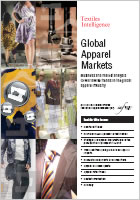Issue
2:
2nd Quarter 2008

Product Overview
Buy this Report now
Buy this Issue now
Subscribe
Download brochure (PDF)
Download price list (PDF)
Price list download
| Please choose your preferred currency:
|
Request sample issue
View list of reports
in other issues
|
Multi Report Package |
We also offer a flexible subscription product,
the Multi Report Package,
which allows you to select your own choice of reports from our full range,
to suit your own budget.
Click here for full details.
|
|
 |
Trade and trade policy: leading clothing suppliers to the USA |

28 pages,
published in Issue 2, 2nd Quarter 2008
Report price:
Euro 395.00;
US$ 520.00
|
US clothing imports rose in value by 3.2% to US$73.9 bn in 2007. In terms of volume, imports were up by 3.5% to 23.3 bn sme (square metres equivalent). In the first four months of 2008, however, imports were down compared with the first four months of 2007. Indeed, clothing imports fell by 3.7% in value and by 2.9% in volume. A major reason for the drop in trade during the first four months of 2008 was a weak US economy.
China was the largest clothing supplier to the USA in 2007 and during January- April 2008. However, imports from the country fell during the latter period because of a decline in demand in the US market and a deterioration in the competitiveness of Chinese manufacturers in the US market. Imports from Vietnam, on the other hand, have grown strongly since the country joined the World Trade Organisation (WTO) on January 11, 2007. Indeed, many clothing buyers which placed orders with Chinese manufacturers in 2007 appear to have shifted their sourcing to Vietnam during January- April 2008. Furthermore, several Chinese producers have set up new operations in Vietnam in search of lower labour costs since the beginning of 2008.
Clothing imports from four other supplying countries?namely Bangladesh, Cambodia, Honduras and Indonesia?grew in 2007 and in January-April 2008. But imports from Mexico and Thailand fell during these periods.
In terms of product categories, the ten most popular clothing items in 2007 were women's and girls' cotton knit shirts, women's and girls' cotton trousers, men's and boys' cotton knit shirts, men's and boy's cotton trousers, men's and boys' cotton non-knit shirts, women's and girls' man-made fibre knit shirts, cotton and man-made fibre baby garments, cotton underwear, men's and boys' man-made fibre trousers and man-made fibre bras.
Several trade policy announcements have been made since the beginning of 2007. Some policies aim for improved collaboration between important groups of clothing producing countries?such as those made by governments in India, Sri Lanka and Pakistan?while others aim to protect domestic industries from low cost Asian imports, including government policies made in the USA and Mexico.
| Global Apparel Markets provides intelligence, analysis and insight on the global apparel industry. |  | What's in it?
Each issue contains: essential information on trade and trade policy; news from leading brands, companies and other organisations; analysis of key geographical markets; and expert opinions on strategy. A single issue of Global Apparel Markets includes:  practical and strategic advice from industry experts practical and strategic advice from industry experts  a report on a key geographical market a report on a key geographical market  a round-up of the latest product innovations a round-up of the latest product innovations  a feature on trade and trade policy a feature on trade and trade policy  comprehensive information on the latest business developments comprehensive information on the latest business developments
An annual subscription to Global Apparel Markets is a cost-effective way to keep informed about trends and developments in the global apparel industry. Subscriptions are available in printed and/or digital formats. Printed and digital subscribers receive each issue in printed format in addition to a digital PDF file, which is available immediately on publication. Subscribers also receive a complementary digital subscription to Global Apparel Update, delivered directly by email once a month. This free supplement contains essential information on business news and the latest product developments. Like all Textiles Intelligence publications, Global Apparel Markets is a reliable source of independently sourced business information, and it does not carry advertising.
| This is what our customers say: |
"In our work, we were looking for industry insights and trends - who the major suppliers were, which countries were producing and what, productivity rates, investment incentives, where investors were moving to and why, etc. A lot of the individual country case studies you did were great - I remember one recently on the UK for example. There was also a great article from a guy on the Turkish market and recent trends there. Both these articles were written for the layman so they were easy to understand but comprehensive at the same time.
The technology articles were also interesting.
Basically, it was an all-round good publication that covered everything in enough depth so that you would always find something of interest in each issue." |
| (Alan J. Saffery; Competitiveness, Private Sector & Economic Growth ; Saffery Consulting) |
|
|
 |
